Input interpretation

H_2O water + Cl_2 chlorine + AgNO_3 silver nitrate ⟶ HNO_3 nitric acid + AgCl silver chloride + AgClO_3 silver chlorate
Balanced equation
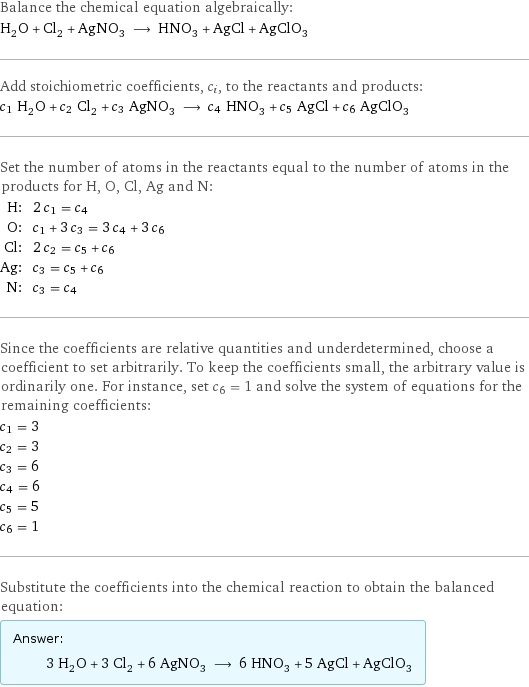
Balance the chemical equation algebraically: H_2O + Cl_2 + AgNO_3 ⟶ HNO_3 + AgCl + AgClO_3 Add stoichiometric coefficients, c_i, to the reactants and products: c_1 H_2O + c_2 Cl_2 + c_3 AgNO_3 ⟶ c_4 HNO_3 + c_5 AgCl + c_6 AgClO_3 Set the number of atoms in the reactants equal to the number of atoms in the products for H, O, Cl, Ag and N: H: | 2 c_1 = c_4 O: | c_1 + 3 c_3 = 3 c_4 + 3 c_6 Cl: | 2 c_2 = c_5 + c_6 Ag: | c_3 = c_5 + c_6 N: | c_3 = c_4 Since the coefficients are relative quantities and underdetermined, choose a coefficient to set arbitrarily. To keep the coefficients small, the arbitrary value is ordinarily one. For instance, set c_6 = 1 and solve the system of equations for the remaining coefficients: c_1 = 3 c_2 = 3 c_3 = 6 c_4 = 6 c_5 = 5 c_6 = 1 Substitute the coefficients into the chemical reaction to obtain the balanced equation: Answer: | | 3 H_2O + 3 Cl_2 + 6 AgNO_3 ⟶ 6 HNO_3 + 5 AgCl + AgClO_3
Structures
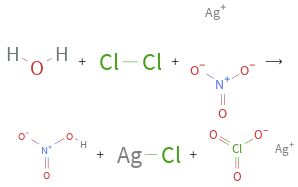
+ + ⟶ + +
Names

water + chlorine + silver nitrate ⟶ nitric acid + silver chloride + silver chlorate
Reaction thermodynamics
Gibbs free energy
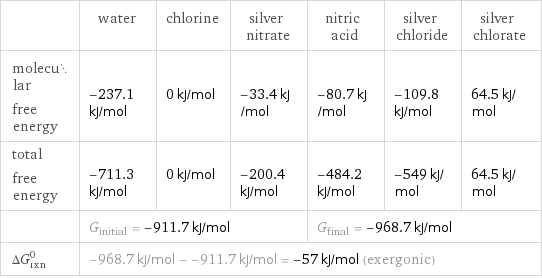
| water | chlorine | silver nitrate | nitric acid | silver chloride | silver chlorate molecular free energy | -237.1 kJ/mol | 0 kJ/mol | -33.4 kJ/mol | -80.7 kJ/mol | -109.8 kJ/mol | 64.5 kJ/mol total free energy | -711.3 kJ/mol | 0 kJ/mol | -200.4 kJ/mol | -484.2 kJ/mol | -549 kJ/mol | 64.5 kJ/mol | G_initial = -911.7 kJ/mol | | | G_final = -968.7 kJ/mol | | ΔG_rxn^0 | -968.7 kJ/mol - -911.7 kJ/mol = -57 kJ/mol (exergonic) | | | | |
Entropy

| water | chlorine | silver nitrate | nitric acid | silver chloride | silver chlorate molecular entropy | 69.91 J/(mol K) | 223 J/(mol K) | 140.9 J/(mol K) | 156 J/(mol K) | 96.3 J/(mol K) | 142 J/(mol K) total entropy | 209.7 J/(mol K) | 669 J/(mol K) | 845.4 J/(mol K) | 936 J/(mol K) | 481.5 J/(mol K) | 142 J/(mol K) | S_initial = 1724 J/(mol K) | | | S_final = 1560 J/(mol K) | | ΔS_rxn^0 | 1560 J/(mol K) - 1724 J/(mol K) = -164.6 J/(mol K) (exoentropic) | | | | |
Equilibrium constant
![Construct the equilibrium constant, K, expression for: H_2O + Cl_2 + AgNO_3 ⟶ HNO_3 + AgCl + AgClO_3 Plan: • Balance the chemical equation. • Determine the stoichiometric numbers. • Assemble the activity expression for each chemical species. • Use the activity expressions to build the equilibrium constant expression. Write the balanced chemical equation: 3 H_2O + 3 Cl_2 + 6 AgNO_3 ⟶ 6 HNO_3 + 5 AgCl + AgClO_3 Assign stoichiometric numbers, ν_i, using the stoichiometric coefficients, c_i, from the balanced chemical equation in the following manner: ν_i = -c_i for reactants and ν_i = c_i for products: chemical species | c_i | ν_i H_2O | 3 | -3 Cl_2 | 3 | -3 AgNO_3 | 6 | -6 HNO_3 | 6 | 6 AgCl | 5 | 5 AgClO_3 | 1 | 1 Assemble the activity expressions accounting for the state of matter and ν_i: chemical species | c_i | ν_i | activity expression H_2O | 3 | -3 | ([H2O])^(-3) Cl_2 | 3 | -3 | ([Cl2])^(-3) AgNO_3 | 6 | -6 | ([AgNO3])^(-6) HNO_3 | 6 | 6 | ([HNO3])^6 AgCl | 5 | 5 | ([AgCl])^5 AgClO_3 | 1 | 1 | [AgClO3] The equilibrium constant symbol in the concentration basis is: K_c Mulitply the activity expressions to arrive at the K_c expression: Answer: | | K_c = ([H2O])^(-3) ([Cl2])^(-3) ([AgNO3])^(-6) ([HNO3])^6 ([AgCl])^5 [AgClO3] = (([HNO3])^6 ([AgCl])^5 [AgClO3])/(([H2O])^3 ([Cl2])^3 ([AgNO3])^6)](../image_source/4670dead4d675b456a9a26c2d02fa2fa.png)
Construct the equilibrium constant, K, expression for: H_2O + Cl_2 + AgNO_3 ⟶ HNO_3 + AgCl + AgClO_3 Plan: • Balance the chemical equation. • Determine the stoichiometric numbers. • Assemble the activity expression for each chemical species. • Use the activity expressions to build the equilibrium constant expression. Write the balanced chemical equation: 3 H_2O + 3 Cl_2 + 6 AgNO_3 ⟶ 6 HNO_3 + 5 AgCl + AgClO_3 Assign stoichiometric numbers, ν_i, using the stoichiometric coefficients, c_i, from the balanced chemical equation in the following manner: ν_i = -c_i for reactants and ν_i = c_i for products: chemical species | c_i | ν_i H_2O | 3 | -3 Cl_2 | 3 | -3 AgNO_3 | 6 | -6 HNO_3 | 6 | 6 AgCl | 5 | 5 AgClO_3 | 1 | 1 Assemble the activity expressions accounting for the state of matter and ν_i: chemical species | c_i | ν_i | activity expression H_2O | 3 | -3 | ([H2O])^(-3) Cl_2 | 3 | -3 | ([Cl2])^(-3) AgNO_3 | 6 | -6 | ([AgNO3])^(-6) HNO_3 | 6 | 6 | ([HNO3])^6 AgCl | 5 | 5 | ([AgCl])^5 AgClO_3 | 1 | 1 | [AgClO3] The equilibrium constant symbol in the concentration basis is: K_c Mulitply the activity expressions to arrive at the K_c expression: Answer: | | K_c = ([H2O])^(-3) ([Cl2])^(-3) ([AgNO3])^(-6) ([HNO3])^6 ([AgCl])^5 [AgClO3] = (([HNO3])^6 ([AgCl])^5 [AgClO3])/(([H2O])^3 ([Cl2])^3 ([AgNO3])^6)
Rate of reaction
![Construct the rate of reaction expression for: H_2O + Cl_2 + AgNO_3 ⟶ HNO_3 + AgCl + AgClO_3 Plan: • Balance the chemical equation. • Determine the stoichiometric numbers. • Assemble the rate term for each chemical species. • Write the rate of reaction expression. Write the balanced chemical equation: 3 H_2O + 3 Cl_2 + 6 AgNO_3 ⟶ 6 HNO_3 + 5 AgCl + AgClO_3 Assign stoichiometric numbers, ν_i, using the stoichiometric coefficients, c_i, from the balanced chemical equation in the following manner: ν_i = -c_i for reactants and ν_i = c_i for products: chemical species | c_i | ν_i H_2O | 3 | -3 Cl_2 | 3 | -3 AgNO_3 | 6 | -6 HNO_3 | 6 | 6 AgCl | 5 | 5 AgClO_3 | 1 | 1 The rate term for each chemical species, B_i, is 1/ν_i(Δ[B_i])/(Δt) where [B_i] is the amount concentration and t is time: chemical species | c_i | ν_i | rate term H_2O | 3 | -3 | -1/3 (Δ[H2O])/(Δt) Cl_2 | 3 | -3 | -1/3 (Δ[Cl2])/(Δt) AgNO_3 | 6 | -6 | -1/6 (Δ[AgNO3])/(Δt) HNO_3 | 6 | 6 | 1/6 (Δ[HNO3])/(Δt) AgCl | 5 | 5 | 1/5 (Δ[AgCl])/(Δt) AgClO_3 | 1 | 1 | (Δ[AgClO3])/(Δt) (for infinitesimal rate of change, replace Δ with d) Set the rate terms equal to each other to arrive at the rate expression: Answer: | | rate = -1/3 (Δ[H2O])/(Δt) = -1/3 (Δ[Cl2])/(Δt) = -1/6 (Δ[AgNO3])/(Δt) = 1/6 (Δ[HNO3])/(Δt) = 1/5 (Δ[AgCl])/(Δt) = (Δ[AgClO3])/(Δt) (assuming constant volume and no accumulation of intermediates or side products)](../image_source/6a6cd83d416b4112324a396b45c1b48f.png)
Construct the rate of reaction expression for: H_2O + Cl_2 + AgNO_3 ⟶ HNO_3 + AgCl + AgClO_3 Plan: • Balance the chemical equation. • Determine the stoichiometric numbers. • Assemble the rate term for each chemical species. • Write the rate of reaction expression. Write the balanced chemical equation: 3 H_2O + 3 Cl_2 + 6 AgNO_3 ⟶ 6 HNO_3 + 5 AgCl + AgClO_3 Assign stoichiometric numbers, ν_i, using the stoichiometric coefficients, c_i, from the balanced chemical equation in the following manner: ν_i = -c_i for reactants and ν_i = c_i for products: chemical species | c_i | ν_i H_2O | 3 | -3 Cl_2 | 3 | -3 AgNO_3 | 6 | -6 HNO_3 | 6 | 6 AgCl | 5 | 5 AgClO_3 | 1 | 1 The rate term for each chemical species, B_i, is 1/ν_i(Δ[B_i])/(Δt) where [B_i] is the amount concentration and t is time: chemical species | c_i | ν_i | rate term H_2O | 3 | -3 | -1/3 (Δ[H2O])/(Δt) Cl_2 | 3 | -3 | -1/3 (Δ[Cl2])/(Δt) AgNO_3 | 6 | -6 | -1/6 (Δ[AgNO3])/(Δt) HNO_3 | 6 | 6 | 1/6 (Δ[HNO3])/(Δt) AgCl | 5 | 5 | 1/5 (Δ[AgCl])/(Δt) AgClO_3 | 1 | 1 | (Δ[AgClO3])/(Δt) (for infinitesimal rate of change, replace Δ with d) Set the rate terms equal to each other to arrive at the rate expression: Answer: | | rate = -1/3 (Δ[H2O])/(Δt) = -1/3 (Δ[Cl2])/(Δt) = -1/6 (Δ[AgNO3])/(Δt) = 1/6 (Δ[HNO3])/(Δt) = 1/5 (Δ[AgCl])/(Δt) = (Δ[AgClO3])/(Δt) (assuming constant volume and no accumulation of intermediates or side products)
Chemical names and formulas
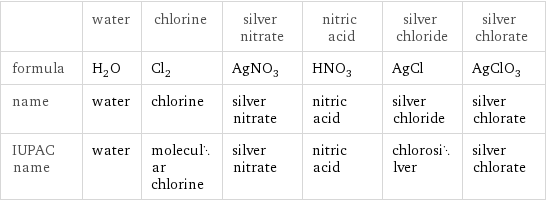
| water | chlorine | silver nitrate | nitric acid | silver chloride | silver chlorate formula | H_2O | Cl_2 | AgNO_3 | HNO_3 | AgCl | AgClO_3 name | water | chlorine | silver nitrate | nitric acid | silver chloride | silver chlorate IUPAC name | water | molecular chlorine | silver nitrate | nitric acid | chlorosilver | silver chlorate
Substance properties
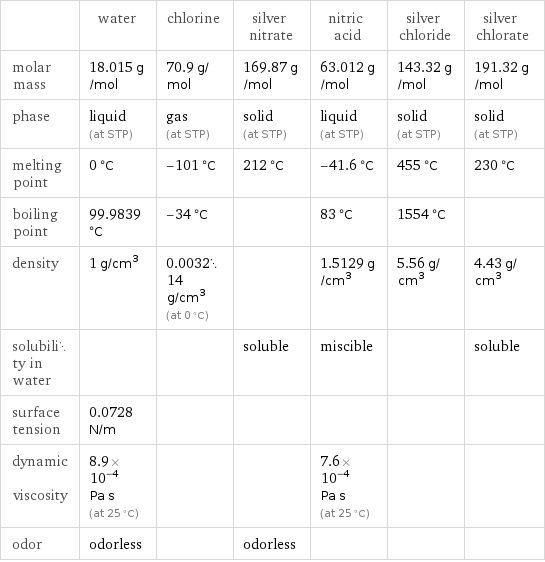
| water | chlorine | silver nitrate | nitric acid | silver chloride | silver chlorate molar mass | 18.015 g/mol | 70.9 g/mol | 169.87 g/mol | 63.012 g/mol | 143.32 g/mol | 191.32 g/mol phase | liquid (at STP) | gas (at STP) | solid (at STP) | liquid (at STP) | solid (at STP) | solid (at STP) melting point | 0 °C | -101 °C | 212 °C | -41.6 °C | 455 °C | 230 °C boiling point | 99.9839 °C | -34 °C | | 83 °C | 1554 °C | density | 1 g/cm^3 | 0.003214 g/cm^3 (at 0 °C) | | 1.5129 g/cm^3 | 5.56 g/cm^3 | 4.43 g/cm^3 solubility in water | | | soluble | miscible | | soluble surface tension | 0.0728 N/m | | | | | dynamic viscosity | 8.9×10^-4 Pa s (at 25 °C) | | | 7.6×10^-4 Pa s (at 25 °C) | | odor | odorless | | odorless | | |
Units
